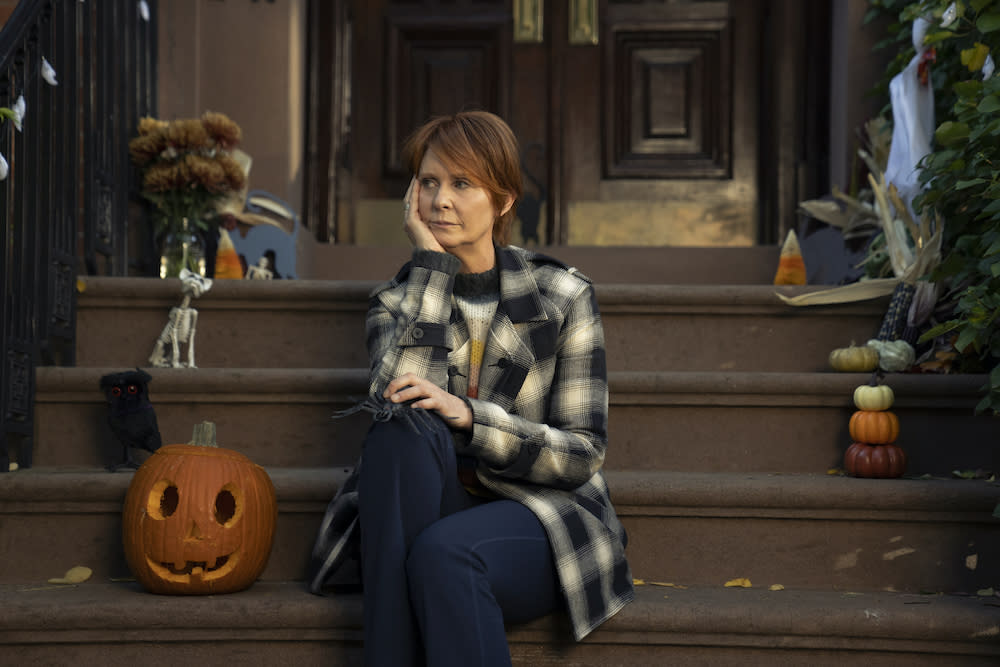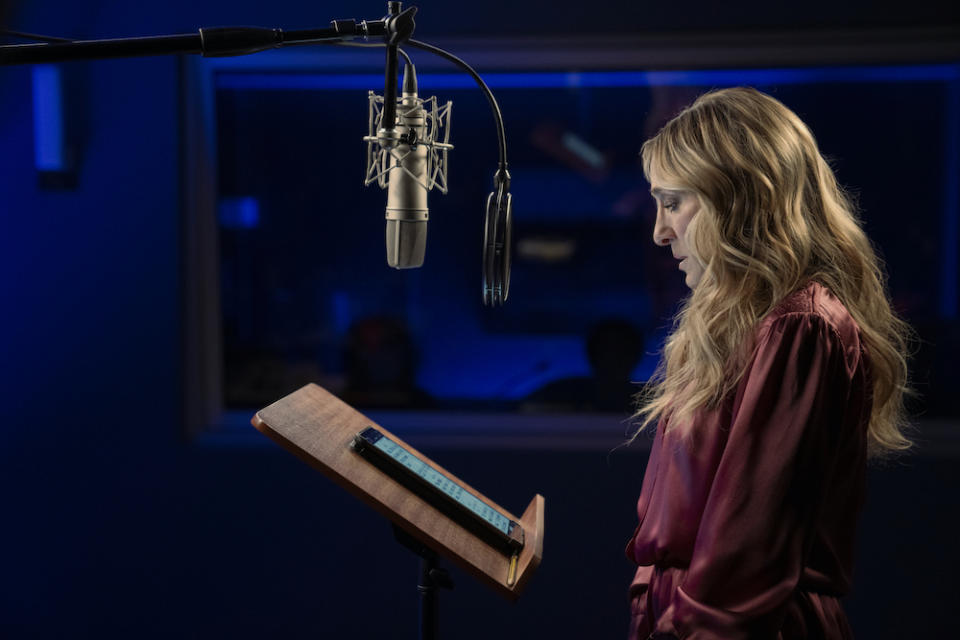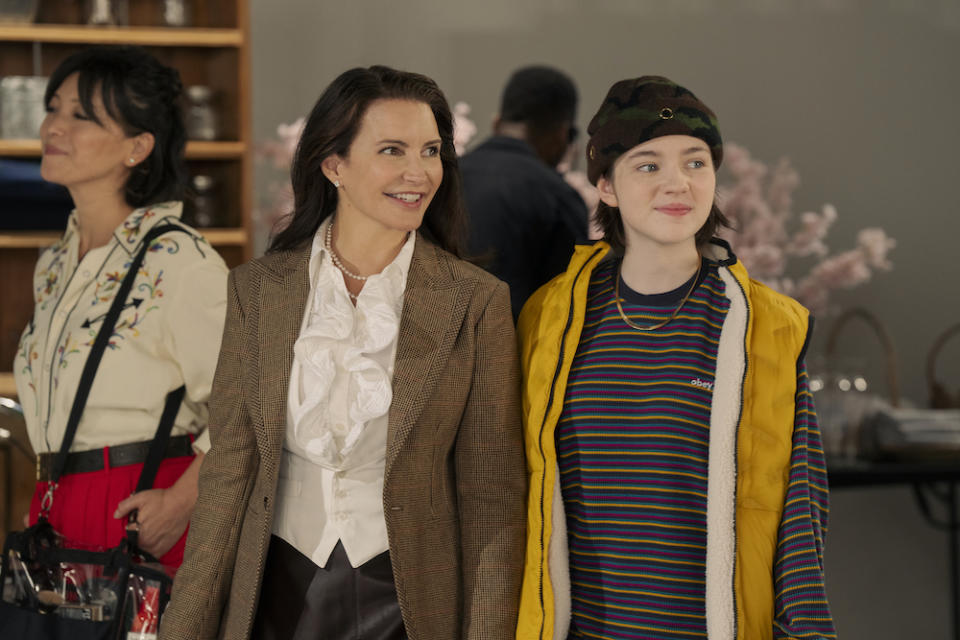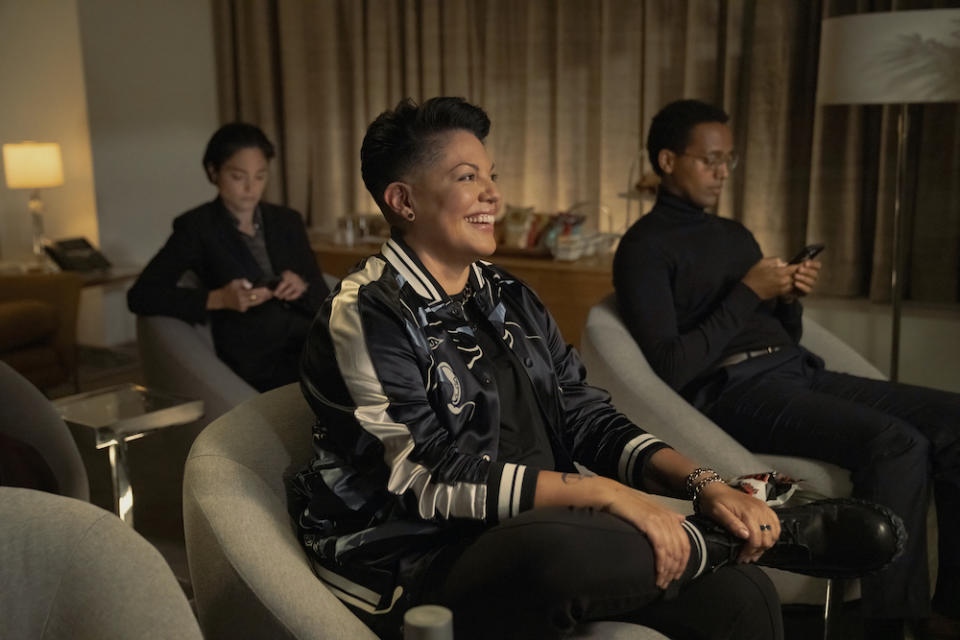What the Hell Is Happening in ‘And Just Like That…’?

- Oops!Something went wrong.Please try again later.
- Oops!Something went wrong.Please try again later.
- Oops!Something went wrong.Please try again later.
[Editor’s Note: The following article contains spoilers for “And Just Like That” Season 2, through Episode 5, “Trick or Treat.”]
When “And Just Like That…” premiered, it got to the point, fast. Big (Chris Noth) was dead before the end of the first hour, and Carrie (Sarah Jessica Parker) was alone again, with only her untold millions to comfort her. Killing off a key character or two is a standard practice when it comes to revivals, implemented in everything from “Night Court” to “Will & Grace,” but “And Just Like That…” made Big’s death the series’ center. The first season was clearly about Carrie grieving her loss, finding a fresh path, and walking into that uncertain future.
More from IndieWire
When it comes to similar purpose, all Season 2 can muster is uncertainty. At times, it feels like an extension of Season 1 — aka, it’s still all about Big, or, at least, it’s still all about Carrie grieving and finding her way forward. At other times, it seems like it’s moving past Season 1, into something lighter — something closer to the original “Sex and the City.” Everyone is dating, and everyone is meeting for meals to talk about dating. But its heavy subject matter — Big’s death, Miranda’s (Cynthia Nixon) separation, Nya’s (Karen Pittman) separation — in addition to Samantha’s (Kim Cattrall) impossible-to-overlook absence keep “And Just Like That” from fully reconnecting with its predecessor. It’s not “Sex and the City 2.0,” nor should it want to be.
“And Just Like That” is stuck looking forward and backward at the same time. The title, the new characters, the shift in thematic material, and the elongated structure (these episodes skew closer to a weighty hour than a breezy 30 minutes) all emphasize what’s changed, even as old characters keep reemerging, lighthearted plotlines of yesteryear persist, and select scenes seem specifically designed to mirror classic set-ups. Season 2s are hard, no matter what kind of show you’re making, and if this is what it takes for Michael Patrick King’s sequel series to find its footing, so be it. But for now, we’re left wondering what “And Just Like That” is about — what it’s trying to do and where it’s hoping to go.
Now, what a television show is about is very much a subjective interpretation. Not even King can tell the audience what the series really means, since significance will differ from viewer to viewer. Maybe you’re just happy to hate-watch the devolution of your once-favorite gal pals. Maybe you’re connecting on a personal level with, as Anthony puts it in the premiere, their “rich people problems.” Maybe you’re taking a bird’s eye view to see how role models from the early 2000s are adjusting to our current culture. We’re not here to tell you how to watch “And Just Like That.” Quite the opposite. We’re here to figure out how “And Just Like That” hopes it’s being watched. With that in mind, a few theories:
It’s About… Life After Marriage
“Sex and the City” came to mean a lot of things for a lot of people, but at its core, the original series was always about dating and friendship. There’s a reason the climactic moments of the final season revolve around Carrie leaving New York City for Paris (thus, leaving her friends) and choosing who she wants as a partner (Big, who also reunites her with her friends). Plus, the final season sees Miranda marry Steve and move to Brooklyn — which in 2004, apparently, was like moving to Europe — and Charlotte adopting a baby. The first movie doesn’t depart much from those central tenets, focusing on Carrie’s wedding, Steve (David Eigenberg) having an affair, and Charlotte’s surprise pregnancy — natural next steps in their romantic relationships, all tied together by their ongoing friendships.
Among the second film’s many, many struggles was that it’s not really about anything. Carrie’s big issue (and Big issue) is feeling too settled. (The worst thing that happens to her is when Big buys them a TV for the bedroom.) Miranda and Charlotte mainly vent about how hard it is to be a mom while on an all-expenses-paid vacation to Abu Dhabi. (Their toast to moms “without help,” as if paying for full-time childcare is the norm, remains painful to watch.) “Sex and the City 2” wants to be about life after marriage, but it doesn’t have the time or commitment to really dig in.
And just like that… they do. Looking back on the disastrous 2010 film, you can see the seeds of “And Just Like That” being (unintentionally) set. Clearly, King felt restricted writing for a married version of Carrie, so he found a fitting, fruitful way to send her back into singledom. Big’s death doesn’t erase the marriage or significantly alter what the original series was about; instead, it provides an opportunity to examine the oft-unexplored time period after marriage. “Sex and the City” upended and embraced romantic-comedy staples at once — that’s part of what made it revolutionary. With “And Just Like That,” why not apply those same ambitions to what happens after the happy ending?
So far, it has — kind of. To use her own metaphor from Episode 5, Carrie is slowly, haphazardly, getting “back up on the bike.” In Season 1, she has an awkward couple of dates with Peter (Jon Tenney). She then has a fling with her podcast producer, Franklyn (Ivan Hernandez), and she makes out a little bit with George (Peter Hermann). Carrie makes it clear she’s not looking for commitment, but she’s still trying to find love and happiness, even after losing it.
But “And Just Like That” wants to treat these issues separately. Carrie’s time with Franklyn is silly. They try to rewrite ad copy or watch cooking shows in bed. Even when it feels like he wants to shift into more serious territory, she only worries about men’s feelings circa 2023 — are men of this era OK with just sex? Carrie isn’t flashing back to married life with Big or worried about another man replacing him. All those feelings are contained to their own episodes, like when she has to read the chapter of her book on Big’s death.
Outside of Carrie, there’s little interest in the nuanced issues that can crop up when you’re with the same person for decade after decade. Miranda’s marriage surfaces these ideas initially, when she and Steve’s sex life was all but nonexistent, but instead of exploring those challenges, their partnership implodes because of a major transition in her life. Charlotte, meanwhile, is often the comic relief. Harry (Evan Handler) is just there — a happy hubby with his happy wife.
To say “And Just Like That” is to life after marriage as “Sex and the City” was to life leading up to marriage doesn’t really work — not with Carrie and Miranda going through two hard resets and Charlotte coasting along without anything new to report. The writing is too inconsistent to make these character developments feel authentic. Carrie’s works best, but even her grieving period feels too long and too short at the same time. Didn’t she get back on the bike with Franklyn? Or Peter? And what does that mean when it comes to the looming specter of Aidan (John Corbett)? Are we really supposed to think she’s ready to date again, and with him? No, no, no.
It’s About… Death, Actually

I’ll be honest, dear reader: This is my favorite theory. I like it in part because it can apply to almost every TV show in existence (and just about every real-life situation), so if you want to just kick back and enjoy what you’re watching without worrying about any actual meaning, you can just say, “It’s about death,” and move on. To a certain extent, “And Just Like That” earns its morbid motivation.
First off, as I established earlier, it began as a show about death. As you get older, people die. That’s just a fact. Carrie didn’t die — and she will never die — but Big did, and now there’s a person-sized gap in her world that must be filled. Watching Carrie search for that mysterious filler — in her podcast, in her writing, in her friends, old and new — is compelling. She’s in an unwanted but not unique situation, and seeing how she copes brings some of the first season’s best moments. Eventually, she tries dating again. Life finds a way.
But ultimately, Carrie isn’t going to confront death head-on. Perhaps that’s because, again, she’s immortal, or maybe it’s simply because the writers know Carrie cannot fundamentally change, or they’ll risk losing “Sex and the City” forever. She must be protected. She must be a constant. So why not kill Miranda’s marriage instead? In the coming weeks on “And Just Like That,” you’ll see further evidence of just how badly the new series bungled Miranda’s coming out journey, but it’s not like proof is lacking. Before “And Just Like That,” Miranda was an unapologetic careerist with rational goals and Type-A satisfactions. She tried to be as sensible in her romantic pursuits as she was with financial planning and planning planning. (Who do you think coordinated the group’s many hard-to-get dinner reservations?)
Now, Miranda is unemployed and uninterested in gaining employment. She’s irrational to an alarming and alienating extent. She tells Carrie she’s happy in Los Angeles, living her “pretend life” with a stand-up comic, but she’s barely engaging with anything for more than a few minutes. She tries to don a strap-on for the length of a phone call, before ditching it. She cleans up the beach, only to dump out the piles of sea gunk in search of her phone. She gets a tattoo on a whim — and a terrible tattoo, at that.
Let’s face it: Miranda, as we once knew her, is dead. “And Just Like That” wants us to think she’s still there, and opening herself up to new ways of thinking is just part of her coming-out experience. As a straight, cisgender man, I can’t really speak to that, but a) you’ll notice the inconsistencies cited do not mention Che Díaz, and b) I refuse to believe that embracing one’s bisexuality means fundamentally reversing every other aspect of yourself. Even though most behaviors tied to a midlife crisis tend to stem from a fear of dying, Miranda’s unbelievable approach to her own crisis is where the “It’s about death” argument falls apart.
It’s About… Making Mistakes, Without Consequences

This section’s alt-title would be: “It’s About… Hate-Watching.” A recurrent theme of “And Just Like That” is each character making an embarrassing mistake, only for everything to turn out just fine anyway. That can apply to major and minor blunders alike. Take, for example, the way Carrie’s podcast company shuts down. I saw a lot of people chastising Carrie for her prudish refusal to read bad ad copy, which is fair. Anyone who’s been writing about sex in New York City for more than two decades should be able to talk about their vagina. But Carrie was not the reason the business shut down, because that $200 ad buy didn’t represent the missing check needed to keep an entire company afloat.
So no, that’s not her mistake. Her mistake was how flippantly she treated the situation. Franklyn just lost his livelihood, so now’s the perfect time to dump him? And when dozens, if not hundreds, of your fellow employees are out of a job, maybe don’t walk off to your palatial apartment thinking, “And just like that… I freed up my entire week.” Hey, everyone just lost their health insurance, but at least I don’t have to worry about an awkward talk with the hot guy I’m banging!
Many of Carrie’s problems are cushioned by her bank account, and that’s… well, that’s just the way it is, I guess. Losing Big is a deep enough pain that you can still empathize with her, even though she doesn’t have to worry about paying for the funeral (or rent) on top of all that grief. Still, her money — as well as Miranda’s and Charlotte’s — allow them to act oblivious in ways that seem unfathomable to us regular folk. Can you imagine not showing up for work, knowing your boss will just bring in Julianne Moore to replace you? (Carrie, it’s your own damn book! You wrote it, you can read it!) Or getting up and moving to Los Angeles without a second thought about where you’ll live, what you’ll wear, or how you’ll get around? (Miranda’s Uber bills are exactly like Che’s stand-up sets: no laughing matter.) At least Charlotte has to put in the work or face the real, albeit mild, consequences: If she didn’t make Harry do those Kegel exercises, her parades could be confetti-free forever.
But “And Just Like That” is also a consequence-free zone. In Episode 5, I briefly lost my mind in that way that so many viewers frequently do. Charlotte and Harry are dressed up like Elizabeth and Phillip Jennings from “The Americans.” Never mind that Charlotte is cosplaying as Elizabeth sans disguise and Harry is wearing one of Phillip’s character-based wigs. The real issue rises when, irked that no one recognizes their couple’s costume, they try to justify referencing a show that ended five years ago to a stranger: “It was on FX for seven seasons,” Harry says. “It won countless Emmys. And a Peabody!” OK, sure, maybe this dude dressed as Batman should have heard of “The Americans”… except everything Harry just said is wrong. “The Americans” ran for six seasons, not seven. It won four Emmys, and those only came after the spy drama was notoriously shut out of the Primetime categories for three years. And that Peabody? It won two! Which never happens!
Harry, if you’re going to act like a superfan, at least get the basic facts straight.
Perhaps that’s all “And Just Like That” wants to be: a fantasy-land where problems aren’t real. Characters’ mistakes never really come back to haunt them, and the show’s errors will never really be rectified. (For more on the writers’ perspective, check out this interview.) Its purpose is either to rile us up over how good these women have it, or reassure us that everything will be OK in the end (so long as you’re white and/or wealthy). A little venting (or placating) can go a long way. There’s value in escapism. But “And Just Like That” wants more…
It’s About… Repairing “Sex and the City’s” Legacy by Building a New One

Up until this point, these theories — as to what “And Just Like That” is about — have been relegated to the viewer’s perspective, aka what the show means to those of us watching. But that may be a mistake, since one of the more prominent explanations mainly concerns the show’s legacy. In the years since “Sex and the City” went off the air (particularly after the second film came out), the lack of diversity cited in certain critiques gained steam. The series leads are all white. Their husbands/long-term boyfriends are all white. Blair Underwood is the most prominent person of color in the cast, and his character (a doctor) gets dumped by Miranda for a bartender. (Of course, that bartender is Steve, and Underwood’s extreme allure only goes to show, despite his flaws, how much Miranda actually loves Steve — which is a position undermined to an egregious extent in “And Just Like That,” but I digress!)
“And Just Like That” made sure to diversify its cast — one could even argue the new series is about introducing people of color to what was formerly a blindingly white world — and plenty of those actors are doing fine work. Sarita Choudhury as Seema, the smoking, sex-positive real estate agent, more than carries her weight. Karen Pittman balances Dr. Nya Wallace’s messy romantic life and respected career with considerable charm, and no one can top the extravagant looks of Lisa Todd Wexley, so vibrantly embodied by Nicole Ari Parker. (Chris Jackson, as Herbert, matches his wife’s commanding presence, bringing warmth and humor to what could’ve been a stuffy lawyer character. Send dad-buds Herbert and Harry out for a night on the town, stat.)
No one can say the show isn’t more inclusive, but can “And Just Like That” really be about repairing the franchise’s exclusionary legacy if it’s not fully invested in its new characters? Seema is far too obvious a Samantha clone, Nya’s arc is too broad for her character to carry her own stories, Lisa is too often a sounding board for Charlotte to talk about kids and school, and Che… well, I’m not even going to get into the internet’s favorite punching bag. Whether they’re replacing an original character or serving the ones who are still around, each new cast member remains tied to the series’ past rather than carving a conclusive path to its future. With time, “And Just Like That” could deepen and distinguish these characters in a way that makes them just as memorable as Carrie, Miranda, Samantha, and Charlotte, but they haven’t figured out how to do that yet.
It’s About… Reviving “Sex and the City,” and Nothing Else
With that, we’ve arrived at our most cynical take: “And Just Like That” isn’t about anything… except reviving “Sex and the City.” We live in the age of I.P., and television in particular has shown an increasing weakness for franchises, revivals, and reboots. Why think “And Just Like That” is any different? At the outset, it’s good to give a series the benefit of the doubt. Spinoffs like “Better Call Saul,” reboots like “One Day at a Time,” and revivals like “Twin Peaks: The Return” have all proven there’s room for incredible storytelling when mining intellectual property. But midway through Season 2, it’s far too difficult to say what “And Just Like That” is even trying to do with its new episodes. What’s the purpose of this story, if there is one? Where’s the comedy in this situational comedy, if that’s still the best way to describe it? Why are we watching, other than nostalgic compulsion or some weird need to understand what a once-great show has become?
I eagerly await answers, although with each passing week, I grow more skeptical any will actually come.
Grade: C
“And Just Like That…” Season 2 releases new episodes each Thursday on Max. The Season 2 finale is scheduled to debut August 24.
Best of IndieWire
Sign up for Indiewire's Newsletter. For the latest news, follow us on Facebook, Twitter, and Instagram.

